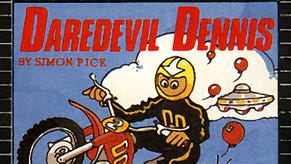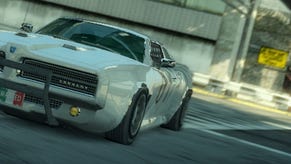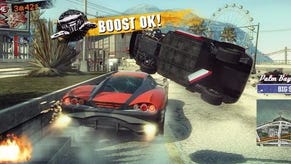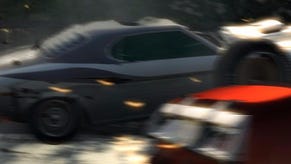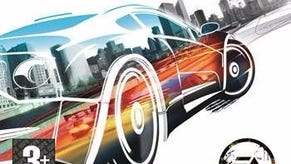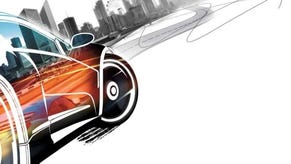Burnout Paradise
Smashing.
Burnout is already synonymous with insane speed, great handling and big crashes. So what's next? Well - parking. Obviously.
Power Parking is one of the many things the new openworld Burnout lets you do. If you feel like it. When you see a pair of cars parked somewhere, it's your choice (in my view, your duty) to use the handbrake to swing your car into the gap between them. Do it without hitting either car or smacking the kerb, and the game will recognise you for it.
That's hardly the extent of the new, of course. The handbrake is different, for one. And the openworld city. And the wholesale rejection of all the crutches upon which all the other Burnouts swung themselves around the room - endless menus, loading screens, instant restarts, online lobbies, and all the rest of it. This is a boundless driving playground in every sense they could think of, blending the disparate styles of the other Burnouts' varied locales into one coherent setting. So much so that if you want to race against a friend you just pull up the Easy Drive gizmo using the d-pad and fire off an invitation. "It's sort of like texting while you drive," says Criterion's Matt Webster. If your friend accepts, your world and his world (I don't know any girls) are brought together, and there you are, racing as one.
Webster's speaking to us in one of EA's cupboards at Games Convention in Leipzig, where Burnout Paradise is belting along on a pair of networked PS3s hooked up to massive LCDs. The level of detail on the screen is as demented as the cars get deformed. "We had to do 60 frames in an openworld," he tells us - and they have. Whatever troubles others are having with next-gen graphics, Criterion seems to be coping. You can tell they've been waiting for this. "We're literally peeling metal off the car," Webster says excitedly. "We're deforming it and warping it and bending it and stretching it in ways we've never done before. We're actually compressing and stretching the chassis, which no one else is doing. We're doing that to traffic as well."
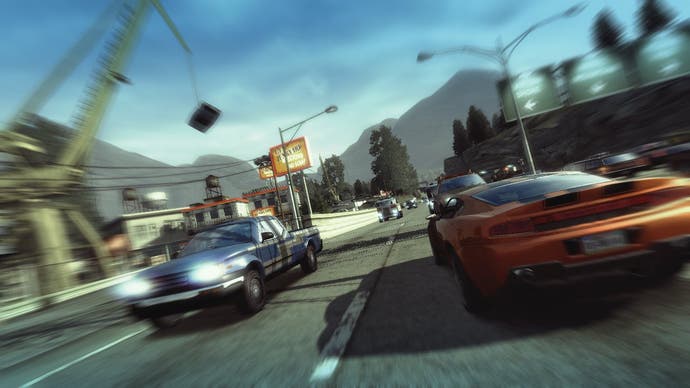
Simply driving around and exploring Paradise (or "Free Burning", as they call it) is the core of the game, and the idea is to keep you occupied even when you're between events. Hence the Power Parking. Hence the endless jumps (Paradise's use of ramps makes GTA look conservative). Hence the "Burnout" signs in awkward places, which you have to try and smash through (c.f. ramps). And hence the Road Rules, a pair of goals for every main road in the game, which act like mini time-trials - swing onto a road, burn along it at record pace, and every time your friends turn into it they're reminded of your best time.
Accessing races and other events is done by pulling up to traffic lights and spinning your wheels. Within seconds you're part of a grid, and then you're off. If you foul up, or fancy doing something else, just turn off somewhere else or pull over and the race dissolves. You can always try again later, and there are 120 junctions to pull up to, so you can always try something else. Progression is handled by building up a record of completed races and other tasks (collected on your Driving Licence, naturally), and the buzzword is "seamless".
"We finished Revenge on the 360 and threw everything away," says Webster, dragging us back to the beginning. "Even the handling - and that's like throwing the crown jewels away." With everything dumped, they set about rebuilding Burnout in its new home, recreating and iterating the handling (and building in a handbrake - the "most requested thing in a Burnout game", apparently), and composing a game that's superficially alien, but comfortably familiar - the "new Burnout game" that a lot of developers would have shied away from making.

Some of the changes jar on the surface, but make sense underneath. Crash mode, one of our favourite bits of the last three games, has certainly taken a turn. "Crash mode as people know it is not going to be. You can't have an openworld experience and have junctions with a set start point," Webster says. "We wanted people to have the Crash experience in a completely new way, an open way." The solution is to allow you to trigger it when you want.
Criterion's mindful, of course, of diminishing its importance, so while Crash will change, Crash will still be Crash in the ways that matter. Asked whether they're opting for a Burnout 3 approach of trying to manoeuvre the car in slow motion between power-ups and Crashbreakers, or a Burnout Revenge "golf swing" of perfect start and target cars, Webster admits it's not all there yet. "We're still throwing ideas around. I think we'll be talking about it more in the coming weeks."
Details aside, as they sadly have to be, the constituent parts of the Burnout experience that culminate in those brilliantly replayable smash frenzies are certainly in place. Visually and aurally, this is Burnout dragged kicking and screaming and apes-in-pain into a new era. Watching a muscle car impact on a bus is like watching an accordion catch a right hook. They're not so precious about ripping you out of the game when you mess up, too, introducing a distinction between crashing and wrecking. The idea is that if you keep your wheels, and land on them, you can drive away. Upside down with your suspension inside out, you'll need a track-reset. What this could mean for Crash is another matter.



